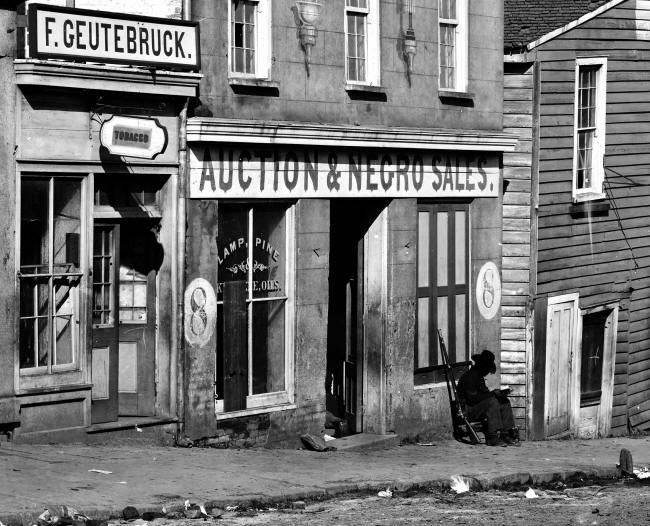This is a peculiar moment in American culture. Slavery doesn’t trouble the psyche of this country in normal times. Although it was a key element on which much of the wealth of the United States was once based, the history of slavery is typically viewed as the prehistory of the Emancipation Proclamation. But a spate of recent publications has pushed the issue to a new level of prominence.
Perhaps one should not draw too many conclusions from the fact that slavery (and in particular, the question of reparations) was the subject of a recent feature in The Atlantic. Ta-Nehisi Coates’ article presents as thorough and eloquent an account of the history of oppression and exploitation of blacks throughout the history of the United States.
The most compelling aspect of Coates’ narrative is the thoroughness with which he rebuts the standard deflections of the American mind when confronted with this issue: sure, things were bad then, but that was then, and this is now. The search for a zero point, a means of neutralizing unpleasant or unpalatable histories, is a common argumentative strategy across the American political spectrum, but it is especially favored by liberals, for whom the blandishments of strict constructionism are merely a variety of atavism.
The idea that there was a new dawn in America with the passage of the Reconstruction Amendments allows the drawing of a comforting line underneath the history of slavery, now viewed as repugnant by common consent. With the elimination of chattel slavery, and the enshrinement of the principle of equal protection in the US Constitution, the liberal mind views the problem as resolved. Any ill-faring thereafter is purely a matter of the failings of individuals, or of their culture.
It is the great virtue of Ta-Nehisi Coates’s article that it shows the myriad ways in which the oppression and expropriation of blacks has persisted in the 150 years since the formal end of slavery. From the exploitation of the share-cropping system, through Jim Crow and the lynch law, to ghettoization, redlining, and the subprime mortgage market, Coates illuminates the variety of ways that race-based dispossession has proceeded in the last century and a half.
Much as he tells a story that most Americans have no excuse for not being familiar with, to begin with (the journalist certainly doesn’t present anything that is new in terms of the available literature,) even this is framed in a way that illustrates the structures of American historical consciousness. For all his righteous (and wholly justified) indignation, Ta-Nehisi Coates merely evinces his own liberalism, albeit of a very progressive sort. The key here is his discussion of Michigan congressman John Conyers’ persistent, quixotic proposal of reparations legislation in the US House of Representatives. Given that this measure is being brought forward in a chamber, many of whose denizens regard food aid for dependent children as an unsupportable frippery, neither Conyers, nor Coates, nor anyone else, can seriously believe that such a measure would ever become law.

As Coates notes, the aim of the exercise is to inspire the necessary public discussion of this issue. Given the quantities of money involved, to say nothing of the large proportion of whites who already buy into the myths of lazy blacks exploiting the welfare state (in the face of mountains of evidence to the contrary) it’s not entirely clear what traction even the most well-meaning of conversation is going to get. In the grip of elite inspired-and-funded Tea Party hysteria which, pace a couple of mainline Republic primary wins shows few signs of abating in the foreseeable future, American blacks, historically constructed by wide swathes of American opinion as the “undeserving poor” are even less likely to get some sort of payout than those adjudged to be “deserving”.
If such a conversation is ever to get underway, one important precursor is a widening of the spread of the available information about this history of slavery to broader segments of the population. Recent books by Greg Grandin and David Brion Davis have taken important steps in this direction.
Grandin, who began his academic career as a historian of Latin America, has consistently broadened his focus. From his early work on mass killings in Guatemala, he has expanded to topics relating to the economic and political history of Latin America, and the Atlantic world more generally. In Fordlandia, Grandin used the history of Henry Ford’s failed attempt to transplant suburban United States to the Amazon jungles of Brazil as a means of tracing a larger history of interactions between Latin America and the resource hungry industries of North America and Europe.
In his latest book, The Empire of Necessity: Slavery, Freedom, and Deception in the New World, Greg Grandin uses the actual history underlying Herman Melville’s Benito Cereno to tell the story of the ways that slavery and freedom functioned within the ideological and economic circuits of the Americas in the late 18th and early 19th centuries. The trajectory of Grandin’s work has been toward more popularly accessible narratives. This is not necessarily a bad thing. The story he has to tell is an important one, and if Grandin substitutes discussions of the characters involved for scholarly apparatus (although the latter is not wholly lacking,) the benefit is that his book is much more likely to be read by the kind of person who needs to read it (i.e. someone not already familiar with its substance and convinced of its truth.)
David Brion Davis’s The Problem of Slavery in the Era of Emancipation is the culmination of his trilogy, the first two volumes of which are The Problem of Slavery in Western Culture (1966) and The Problem of Slavery in the Age of Revolution (1975). These three books center their analyses on the ways that slavery fit into the intellectual culture of the West, throughout the long years and myriad phases of the system’s operation.

In his latest addition to the series, the Yale historian looks at the growth of abolition movements, and the ways that they sought to address the problem of slavery against the backdrop of broadening consensus about the centrality of human liberation to a just political order. Although Davis paints with a broad brush, his special focus on the United States and Great Britain, examines the ways that slavery was condemned or defended in the wake of the Haitian Revolution.
No other single event so focused people of European descent at the time than the Haitian Revolution. In one fell stroke, they were forced to confront black agency in a way that colonialists (and their descendants) had never done. While the prospect of scattered slave rebellions was a constant figure of fear in the slave holding segments of the Americas, the formation of a republic run by former slaves, and the example that it might set for others, had the effect of a sentence to be hanged in a fortnight. This new consciousness of black agency was intimately connected with the schemes for resettlement of former slaves to Africa that obsessed the abolitionist press from the 1820s onward.
David Brion Davis’ book presents an extensive and nuanced account of the ways that the white abolitionist movement interacted with leaders of the black community, and the range of ways that slavery was conceived along a spectrum running from total bondage, through wage slavery, to free manhood. As with Davis’ other books, the research is exemplarily thorough, although the narrative is of a kind that will be intimidating to the average reader. Still, it is an important work in its own right, and a timely contribution to our still-expanding understanding of the history of slavery.
The process of coming to terms with slavery, and subsequent (and continuing) patterns of systemic and institutionalized racial discrimination in the United States, is bound to be a long one. In his article in The Atlantic, Ta-Nehisi Coates references the reparations paid by West Germany to victims of the Holocaust, and to Israel. But these, it should be remembered, were paid by a state which had been subjected to total defeat by the Allies and was in the process of trying to work (and in some respects buy) its way back into the community of civilized nations. East Germany, which was in a similar condition, paid no reparations of any kind (at least with respect to the Holocaust). Perhaps, the fact that their explicit rationale for not doing so was their disinclination to make transfers to (Jewish) capitalists gives a bit of insight into the problem that such a reckoning might have getting traction even on the left. In any case, an even better example might be that of Russia, in which the fact that the collapse of communism occurred without any formal loss of sovereignty meant that the crimes of Stalin and his successors have simply never been addressed.
The publication of books like those mentioned above is certainly positive. Yet the effects of such publications are muted by the determination of important segments of the pedagogical establishment in the United States either to whitewash the brutal history of slavery, or to excise it from primary and secondary curricula altogether. These efforts, which go hand in hand with recent attempts to rehabilitate the Confederacy, constitute important props to a broader attempt to reconfigure US history in ways that make the struggles of those outside the ruling racial and economic elites insignificant, irrelevant, or nonexistent.
As Coates’ essay makes clear, reparations are certainly called for, in terms of justice. Yet it remains unclear, even on the basis of such arguments, what effect this would have on the larger situation of blacks in the United States. Transfer payments might allow black communities redress some of their circumstances by providing better opportunities for aggregating capital. But for reparations to do any good in the long term, they must be part of a broader assessment of the history that gave rise to the injustices, and an addressing of the ways that race and capitalism (neither of which can simply be reduced to the other) are imbricated in the modern United States.
Photographs courtesy of Wikipedia, elycefeliz, and Wikimedia. Published under a Creative Commons license.





